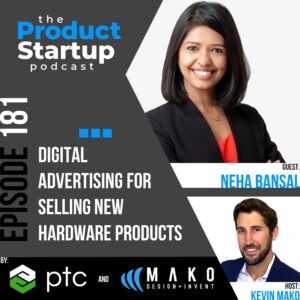With Neha Bansal, PM Lead Meta Ads Manager Reporting
Hosted by Kevin Mako, President of MAKO Design + Invent

Neha is the Lead Product Manager at Meta, overseeing Ads Manager Reporting. Previously, she dedicated five years at Google, where she held various positions, such as Google Analytics Product Lead and Head of Merchant Growth. Neha’s passion for innovation extends beyond her professional endeavours, as she actively invests in numerous startups. Today, she graciously shares invaluable insights tailored for inventors, startups, and small manufacturers. Neha will shed light on the concept of direct-to-consumer digital marketing, impart best practices for leveraging organic content to prepare for paid ads and guide you on maximizing the efficiency and effectiveness of paid digital advertising to propel the growth of your new hardware product.
Today you will hear us talk about:
- What does direct-to-consumer digital advertising entail?
- Direct-to-customer helps you maintain your profit margins.
- Prioritize organic content to initiate unit sales, which helps establish product-market fit.
- Generative AI has significantly reduced the cost and increased the speed and ease of creating organic content.
- Conduct interviews with experts in your product’s domain to generate organic content.
- While blogs are still helpful, people’s interaction with them has changed. Utilize audio, video, and written blogs.
- Identify customers who are fans of your product and encourage them to share their stories and provide reviews.
- Embrace experimentation when running advertisements.
- Instead of starting with a single type of ad, try multiple variations and different advertising approaches.
- Utilize AI to generate a range of options for testing your ads.
- Consider customer segmentation and target audience.
- Understand customer needs, preferences, and pain points.
- Develop personas based on the job to be done or the skill level of your customers and target those specific audiences.
- Take into account branding and positioning.
- Building a brand doesn’t necessarily require a large budget.
- Word-of-mouth marketing holds significant power in brand building.
- Make data-driven decisions by measuring the effectiveness of your expenditures.
- Influencer marketing can often be more cost-effective than traditional marketing.
- Employ creative strategies to attract customers to your hardware product.
- Ensure you set up digital tracking early on to monitor every customer touchpoint.
- Conduct A/B tests and allocate time to analyze the insights.
- Three key factors for hardware sales on digital platforms are campaign objectives, audience targeting, and ad performance analysis.
EPISODE HIGHLIGHTS
- 1:20 – After you have developed a great invention idea into a product, how do you get it to market through digital advertising?
- 3:30 – What is direct-to-customer advertising through digital platforms for a physical consumer hardware product?
- 4:00 – Sell directly to consumers while bypassing traditional distribution channels and intermediary sellers.
- 4:15 – Direct-to-consumer allows a very close relationship with your customers
- 4:30 – How do hardware startups on a budget get to your customers?
- 5:00 – Focus on organic content to sell a few units of your product.
- 5:15 – The cost of creating organic content is far easier and cheaper than ever before through AI tools.
- 5:30 – Use tools to build your content
- 6:30 – Organic content marketing for hardware products is free, can be done by the founder, and is authentic.
- 7:30 – Google has changed its algorithm to include experience and expertise.
- 8:15 – Continue to write blogs, but leverage content tools to increase the types of content and the reach of that content.
- 8:45 – Focus on getting early customer reviews online.
- 9:15 – How do you utilize your organic content into paid content to amplify your audience reach to grow hardware product sales?
- 9:45 – Run multiple different types of mini ads, at a low budget each, to try and find the types of ads that work best for your product.
- 10:30 – Continually iterate your digital ads trying new things
- 11:15 – Return on Adspend (ROAS) is what you should always be trying to improve.
- 12:00 – Technical details of digital campaigns for hardware startups based on best practices from best practices in big companies.
- 12:15 – Know your target audience. Needs, preferences, and pain points.
- 12:45 – Build personas of your hardware customer.
- 13:00 – Branding and positioning. Small businesses can actually build a brand quickly these days.
- 14:15 – Get clarity on the exact opportunity or pain point with your prospective product customer.
- 14:30 – Data-driven analytics.
- 15:00 – Influencer marketing can be much cheaper than traditional marketing.
- 15:45 – How do you maximize return on ad spend for a hardware invention product?
- 16:00 – Set up digital tracking early on.
- 16:30 – Run A/B tests for your website and your ads, then identify the insights.
- 17:00 – Create custom ad audiences.
- 17:30 – Ad performance analysis.
EPISODE LINKS
Neha Bansal Links:
LinkedIn
The Product Startup Podcast Links:
https://www.ProductStartup.com/
Instagram | LinkedIn | Facebook Page | Facebook Group | Pinterest | Twitter | YouTube
PTC Links:
https://www.ptc.com/
OnShape | Creo
Mako Design Links:
https://www.makodesign.com/
YouTube | Instagram | LinkedIn | Facebook | Pinterest | Twitter
Kevin Mako Links:
Instagram | LinkedIn | Quora | Facebook | Twitter
Partner: PTC’s best-in-class software solutions Onshape: The only cloud-native product development platform that delivers full-featured computer-aided design (CAD), integrated product data management (PDM) and enterprise analytics in a single system, and Creo: 3D CAD solution that provides designers with the most innovative tools to build better products faster, such as generative design, additive manufacturing, real-time simulation, IIoT, and augmented reality.











